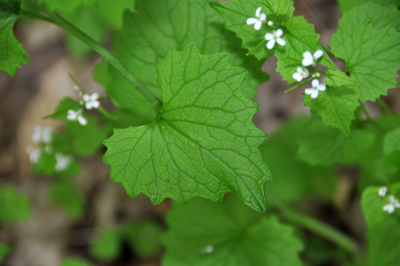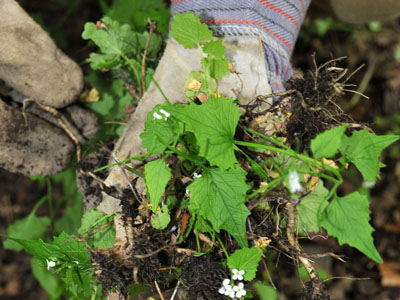Garlic mustard was introduced to North America by European settlers in the 1800s. They used the plant as a potherb and for medicine. Garlic mustard produces a rosette with toothed, heart-shaped leaves which covers the ground in its first year. In the spring, it develops a tall stem with clusters of white flowers that mature into long, thin seed pods.

Now commonly found in southern Ontario, garlic mustard has aggressively covered forest understories by out-competing other plants for light, nutrients, soil, and space. For example, garlic mustard remains green over the winter. This gives the plant an advantage by being ready to photosynthesize and grow once the snow melts, while its understory neighbours are only starting to establish themselves. Other invasive tendencies include releasing chemicals in the soil that suppress growth of native tree seedlings like red and sugar maples and producing thousands of seeds that can be viable in the soil for more than 5 years.
It sounds weedy and scary, so how can garlic mustard as a food source help the environment?
Currently, there is no known predator for garlic mustard in North America, and local deer and animals don’t particularly like the taste, so garlic mustard is usually left alone to grow and spread everywhere. But what about us? Collecting garlic mustard for our food can be a way of locally controlling its invasive population. Maybe we can be its introduced “predator”.
I like to use garlic mustard’s leaves in salads, which give them a nice, strong garlic flavour. Compared to real garlic though, garlic mustard leaves can be slightly bitter – especially later into the season. Many have recommended collecting garlic mustard in early spring or summer for both flavour and weed control.
I have only tried the leaves, but I’ve heard other parts of the plant are edible too. The flowers give a garlic flavour as well, while seeds taste more like mustard, and its roots apparently are something like horse radish.
When collecting garlic mustard, be sure to pull out the whole plant – including the roots! Also, try not to leave any flower s or seedpods lying around - these can still spread this invasive plant! More than just a delicious snack, these simple actions can help to control our urban forests and keep them healthy.

Growing garlic mustard as an edible herb is not practiced anymore nor is it recommended, so after pulling out these delicious invasive weeds in your garden or yard, try to replace them with native edible plants. Clover and wild leek are examples of native understory greens that also provide free, fresh, and local nutrition while also helping the environment.
Here are a couple of interesting recipes with garlic mustard I would like to try, if you end up trying them – let me know how it tastes! Bon appetit!
Raw Garlic Mustard Pesto (M. Sokulski, “A Sign of Spring: Wild Edible Garlic Mustard Returns”)
1 1/2 cups garlic mustard leaves
1 1/2 cups spinach leaves
juice of 1/2 - 1 lemon (to taste)
1 clove garlic (or more to taste)
1/2 cup pine nuts or walnuts
1/4 cup olive oil
salt or tamari to taste
Blend above ingredients in food processor or blender.
Garlic Mustard Soup (G. Reid and S. Yalov, “Garlic Mustard From Pest to Pesto – A Culinary Guide”)
Time required: 50 minutes
Serves: 6
1 ½ shredded garlic mustard
2 chopped carrots
3 potatoes
4 tbsp oregano
6 tbsp basil
3 tbsp minced garlic
½ cup soy sauce
6 cups water
Boil water, add potatoes and carrots. Wait 5-10 minutes and add the rest of the ingredients. Cook for 20-25 minutes.
To learn more about edible trees and plants, check out the upcoming Wild Edibles Nature Walk at High Park on August 21 and our own Edible Tree Tour at Ben Nobleman Park on August 25.
